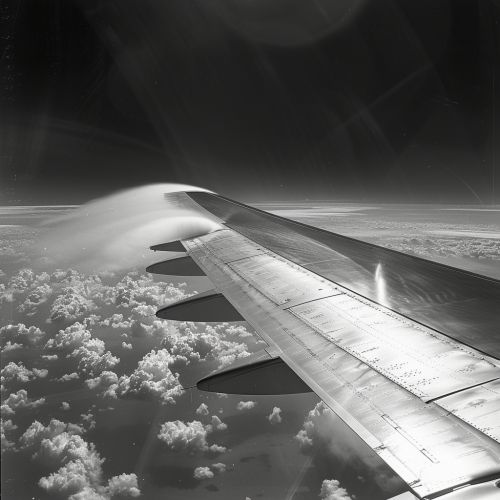Flow Separation
Introduction
Flow separation is a phenomenon in fluid dynamics where the boundary layer of a fluid flow detaches from the surface of a solid body. This occurrence is significant in various engineering applications, including aerodynamics, hydrodynamics, and mechanical engineering. The study of flow separation is crucial for understanding and improving the performance of vehicles, turbines, and other systems where fluid flow plays a critical role.
Fundamentals of Flow Separation
Flow separation occurs when the boundary layer, which is the thin layer of fluid in immediate contact with a solid surface, experiences an adverse pressure gradient. This gradient causes the fluid particles to decelerate and eventually reverse direction, leading to a detachment from the surface. The point at which this detachment occurs is known as the separation point.
Boundary Layer
The boundary layer is a fundamental concept in fluid dynamics, introduced by Ludwig Prandtl in 1904. It is the region of fluid flow near a solid surface where viscous forces are significant. The boundary layer can be classified into two types: laminar and turbulent. In a laminar boundary layer, the fluid particles move in smooth, parallel layers, while in a turbulent boundary layer, the flow is chaotic and characterized by eddies and vortices.
Adverse Pressure Gradient
An adverse pressure gradient occurs when the pressure increases in the direction of the flow. This gradient opposes the motion of the fluid particles, causing them to decelerate. When the deceleration is sufficient, the fluid particles can no longer adhere to the surface, leading to flow separation. The adverse pressure gradient is a critical factor in determining the location and extent of flow separation.
Causes of Flow Separation
Flow separation can be caused by various factors, including:
Surface Geometry
The shape of the surface over which the fluid flows significantly influences flow separation. Sharp edges, sudden changes in surface curvature, and bluff bodies can induce separation. For example, the flow over a cylinder or a sphere often experiences separation due to the abrupt change in surface curvature.
Reynolds Number
The Reynolds number is a dimensionless quantity that characterizes the flow regime. It is defined as the ratio of inertial forces to viscous forces and is given by the formula:
\[ Re = \frac{\rho u L}{\mu} \]
where \( \rho \) is the fluid density, \( u \) is the flow velocity, \( L \) is the characteristic length, and \( \mu \) is the dynamic viscosity. High Reynolds numbers typically indicate turbulent flow, which can delay separation, while low Reynolds numbers are associated with laminar flow, which is more prone to separation.
Surface Roughness
Surface roughness can also affect flow separation. A rough surface can induce early transition from laminar to turbulent flow, which can delay separation. Conversely, a smooth surface may maintain laminar flow longer, leading to earlier separation.
Effects of Flow Separation
Flow separation has several significant effects on fluid flow and the performance of engineering systems:
Drag Increase
One of the primary consequences of flow separation is an increase in drag. When the boundary layer separates, it creates a wake region with low pressure behind the object. This pressure difference between the front and rear of the object results in increased form drag, which can reduce the efficiency of vehicles and other systems.
Loss of Lift
In aerodynamic applications, flow separation can lead to a loss of lift. For example, on an airfoil, separation can cause a dramatic decrease in lift, leading to stall. This phenomenon is critical in the design and operation of aircraft, as it can affect stability and control.
Vibration and Noise
Flow separation can also induce vibrations and noise. The unsteady wake formed by the separated flow can cause fluctuating forces on the surface, leading to vibrations. Additionally, the turbulent wake can generate noise, which is a concern in applications such as wind turbines and automotive design.
Control of Flow Separation
Various techniques are employed to control flow separation and mitigate its adverse effects:
Boundary Layer Suction
Boundary layer suction involves removing a portion of the boundary layer fluid through small holes or slots on the surface. This technique reduces the boundary layer thickness and delays separation. It is commonly used in high-performance aircraft and turbine blades.
Vortex Generators
Vortex generators are small devices placed on the surface to create vortices in the boundary layer. These vortices enhance mixing and increase the momentum of the boundary layer, delaying separation. Vortex generators are widely used in aircraft wings and wind turbine blades.
Surface Coatings
Special surface coatings can be applied to reduce flow separation. These coatings can alter the surface roughness or create microstructures that influence the boundary layer behavior. For example, riblets are small, longitudinal grooves that can reduce drag by delaying separation.
Applications and Implications
Flow separation is a critical consideration in various engineering applications:
Aerodynamics
In aerodynamics, flow separation affects the performance of aircraft, automobiles, and other vehicles. Controlling separation is essential for improving fuel efficiency, stability, and control. Techniques such as winglets, leading-edge extensions, and active flow control are employed to manage separation in aircraft design.
Hydrodynamics
In hydrodynamics, flow separation influences the performance of ships, submarines, and underwater vehicles. Reducing separation can decrease drag and improve propulsion efficiency. Hull design, surface coatings, and flow control devices are used to manage separation in marine applications.
Turbomachinery
In turbomachinery, flow separation can affect the performance of compressors, turbines, and pumps. Separation can lead to efficiency losses, increased vibrations, and noise. Techniques such as blade shaping, boundary layer control, and surface treatments are employed to mitigate separation in turbomachinery.
Research and Development
Ongoing research in flow separation aims to develop new techniques and technologies for controlling separation and improving system performance. Computational fluid dynamics (CFD) simulations, wind tunnel testing, and experimental studies are used to investigate flow separation and develop innovative solutions.
Conclusion
Flow separation is a complex phenomenon with significant implications for various engineering applications. Understanding the causes, effects, and control techniques of flow separation is essential for optimizing the performance of vehicles, turbines, and other systems. Ongoing research and development efforts continue to advance our knowledge and capabilities in managing flow separation.


